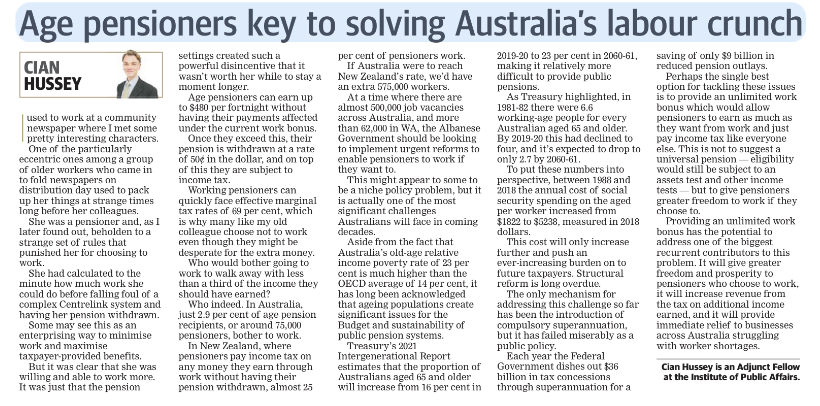
Article by Cian Hussey courtesy of the West Australian.

I used to work at a community newspaper where I met some pretty interesting characters. One of the particularly eccentric ones among a group of older workers who came in to fold newspapers on distribution day used to pack up her things at strange times long before her colleagues. She was a pensioner and, as I later found out, beholden to a strange set of rules that punished her for choosing to work.
She had calculated to the minute how much work she could do before falling foul of a complex Centrelink system and having her pension withdrawn. Some may see this as an enterprising way to minimise work and maximise taxpayer-provided benefits. But it was clear that she was willing and able to work more, it was just that the pension settings created such a powerful disincentive that it wasn’t worth her while to stay a moment longer.
Age pensioners can earn up to $480 per fortnight without having their payments affected under the current work bonus. Once they exceed this, their pension is withdrawn at a rate of 50 cents in the dollar, and on top of this they are subject to income tax. Working pensioners can quickly face effective marginal tax rates of 69 per cent, which is why many like my old colleague choose not to work even though they might be desperate for the extra money.
Who would bother going to work to walk away with less than a third of the income they should have earned?
Who indeed. In Australia, just 2.9 per cent of age pension recipients, or around 75,000 pensioners, bother to work. In New Zealand, where pensioners pay income tax on any money they earn through work without having their pension withdrawn, almost 25 per cent of pensioners work. If Australia were to reach New Zealand’s rate, we’d have an extra 575,000 workers.
At a time where there are almost 500,000 job vacancies across Australia, and more than 62,000 in WA, the Albanese Government should be looking to implement urgent reforms to enable pensioners to work if they want to.
This might appear to some to be a niche policy problem, but it is actually one of the most significant challenges Australians will face in coming decades. Aside from the fact that Australia’s old-age relative income poverty rate of 23 per cent is much higher than the OECD average of 14 per cent, it has long been acknowledged that aging populations create significant issues for the Budget and sustainability of public pension systems.
Treasury’s 2021 Intergenerational Report estimates that the proportion of Australians aged 65 and older will increase from 16 per cent in 2019-20 to 23 per cent in 2060-61, making it relatively more difficult to provide public pensions. As Treasury highlighted, in 1981-82 there were 6.6 working age people for every Australian aged 65 and older. By 2019-20 this had declined to four, and it’s expected to drop to only 2.7 by 2060-61.
To put these numbers into perspective, between 1988 and 2018 the annual cost of social security spending on the aged per worker increased from $1822 to $5238, measured in 2018 dollars.
This cost will only increase further and push an ever-increasing burden onto future taxpayers. Structural reform is long overdue.
The only mechanism for addressing this challenge so far has been the introduction of compulsory superannuation, but it has failed miserably as a public policy. Each year the Federal Government dishes out $36 billion in tax concessions through superannuation for a saving of only $9 billion in reduced pension outlays.
Perhaps the single best option for tackling these issues is to provide an unlimited work bonus which would allow pensioners to earn as much as they want from work and just pay income tax like everyone else. This is not to suggest a universal pension — eligibility would still be subject to an assets test and other income tests — but to give pensioners greater freedom to work if they choose to.
Providing an unlimited work bonus has the potential to address one of the biggest recurrent contributors to this problem. It will give greater freedom and prosperity to pensioners who choose to work, it will increase revenue from the tax on additional income earned, and it will provide immediate relief to businesses across Australia struggling with worker shortages.
Cian Hussey is an Adjunct Fellow at the Institute of Public Affairs.















